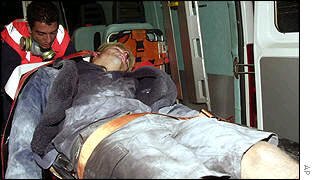
Genoa police 'admit fabrication'
7 January, 2003

|
Rai Uno television
|
A senior officer, Pietro Troiani, reportedly admitted under questioning that two petrol bombs allegedly found at the school were planted by police to justify the raid.
In fact, they had been found elsewhere in the city, in the Corsa Italia, where protesters and police had clashed earlier in the day.
Mr Troiani's lawyer later denied any involvement of his client in fabricating evidence, saying he had only handed the bombs to another police official, reports say.
Police disciplined
Out of 93 people arrested at the school in the early hours of 22 July, 72 suffered injuries, and all were later released without charge.

Police say they found weapons in the school
|
"Now that the investigation into the G8 events is drawing to a close, suspected truths which had already emerged are being officially confirmed," reported the Italian television channel, Rai Uno.
At least 77 police officers have been under investigation for alleged brutality, and three police chiefs have been moved to other jobs.
Transcripts of some of their interviews have been published in Italian newspapers, including Italy's leading left-wing daily, La Repubblica, and the Genoa daily newspaper, Il Secolo XIX.
Demonstrators said riot police beat them with clubs, smashed windows and wrecked computers in the raid.
The BBC's Bill Hayton was among those who stood outside the Diaz school, hearing the screams coming from within, then watching bodies brought out on stretchers.
When the police left he went in and saw blood on the walls, floors and radiators of an upstairs room.
'Simulated' stabbing
One of the key witnesses is Michele Burgio, Mr Troiani's driver, who admits to planting petrol bombs at the school.
According to the media reports, Mr Troiani later admitted to prosecutors that fabricating evidence was a "silly thing" to do.
Attention is also focusing on a knife attack on one police officer, Massimo Nucera.
A senior police chief, Franco Gratteri, head of the Central Operations Services, is quoted as saying that the stabbing was not carried out by protesters, but was simulated.
Mr Gratteri says the "attack" could have been aimed at justifying the excessive use of violence used by some flying squads.
Hundreds of police and protesters were injured in street battles during the summit, which was attended by violent anarchists as well as peaceful protesters.
One protester died after being shot by police.